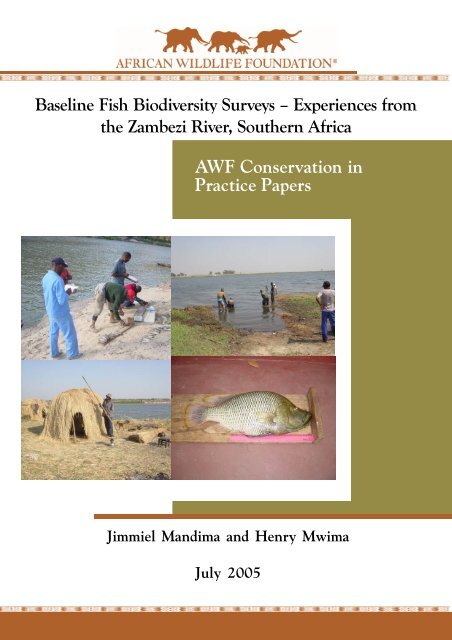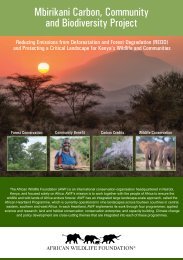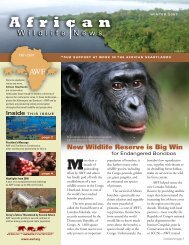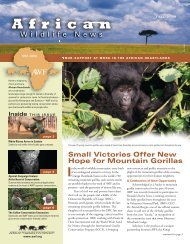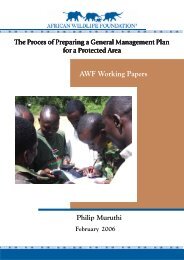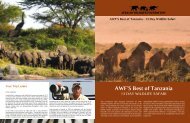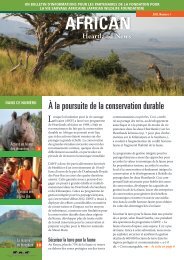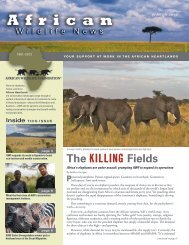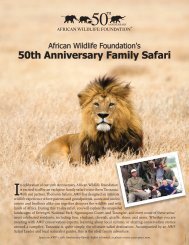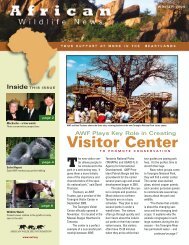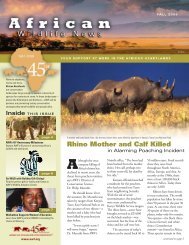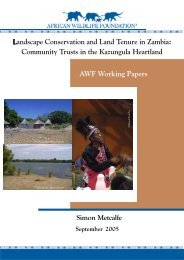Baseline Fish Biodiversity Surveys - African Wildlife Foundation
Baseline Fish Biodiversity Surveys - African Wildlife Foundation
Baseline Fish Biodiversity Surveys - African Wildlife Foundation
- No tags were found...
You also want an ePaper? Increase the reach of your titles
YUMPU automatically turns print PDFs into web optimized ePapers that Google loves.
<strong>Baseline</strong> <strong>Fish</strong> <strong>Biodiversity</strong> <strong>Surveys</strong> – Experiences fromthe Zambezi River, Southern AfricaAWF Conservation inPractice PapersJimmiel Mandima and Henry MwimaJuly 2005
The <strong>African</strong> <strong>Wildlife</strong> <strong>Foundation</strong>,together with the people of Africa,works to ensure the wildlife andwild lands of Africa willendure forever.
About this paper seriesThe AWF Conservation in Practice Paper Series has been designed to disseminate to partners and theconservation community, key lessons learnt and experiences from AWF's <strong>African</strong> Heartlands Program. Thisseries aims to share current work, what lessons have been learnt in order to provide examples that can beadopted by other conservation organizations and players to improve conservation action world wide.About the Authors:: Jimmiel Mandima is the Heartland Coordinator, Zambezi Heartland and an aquatic ecologistwhile Dr. Henry Mwima is the Program Director for the Zambezi Center and is based in Lusaka.Editorial Team: Dr. Helen Gichohi, Dr. Philip Muruthi, Prof. James Kiyiapi, Dr. Patrick Bergin, Joanna Elliottand Daudi SumbaThis essay has been reproduced with permission. Copyright: From Freshwater Ecoregions of Africa andMadagascar by World <strong>Wildlife</strong> Fund. Copyright © 2005 World <strong>Wildlife</strong> Fund. Reproduced with permissionof Island Press, Washington, D.C.This series is coordinated by Daudi Sumba. For more information, please contact publications@awfke.orgCover photos clockwise: <strong>Surveys</strong> teams assessing fish catch on Zambezi River; survey team seining in shallowbay; sample of fish caught by survey team; fishing village on Zambezi: Photo credits AWF.Arusha Center (Tanzania)<strong>African</strong> <strong>Wildlife</strong> <strong>Foundation</strong>Plot 27, Old Moshi RoadP.O. Box 2658ARUSHA, TANZANIATel: +255 27 2509616Fax: +255 27 2544453email: africanwildlife@awf-tz.orgNairobi Center (Kenya)<strong>African</strong> <strong>Wildlife</strong> <strong>Foundation</strong>Britak CentreMara Ragati RoadP.O. Box 48177, 00100NAIROBI, KENYATel: +254 20 2710367Fax: +254 20 2710372email: africanwildlife@awfke.orgKampala Center (Uganda)<strong>African</strong> <strong>Wildlife</strong> <strong>Foundation</strong>Ruth Towers15A Clement Hill RoadP.O. Box 28217KAMPALA, UGANDATel: +256 41 344 510Fax: +256 41 235 824email: africanwildlife@awfug.orgWashington D.C. Center (U.S.A.)<strong>African</strong> <strong>Wildlife</strong> <strong>Foundation</strong>1400 Sixteenth Street, N.W.Suite 120WASHINGTON, D.C. 20036, U.S.A.Tel: +1 202 939 3333Fax: +1 202 939 3332email: africanwildlife@awf.orgWhite River Center (South Africa)<strong>African</strong> <strong>Wildlife</strong> <strong>Foundation</strong>P.O. Box 2977WHITE RIVER 1240,SOUTH AFRICATel: +27 13 751 2483Fax: +27 13 751 3258email: africanwildlife@awfsa.orgZambezi Center (Zambia)<strong>African</strong> <strong>Wildlife</strong> <strong>Foundation</strong>50 Independence AvenueP.O. Box 50844RidgewayLUSAKA, ZAMBIATel: + 260 1 257074Fax: + 260 1 257098email: africanwildlife@iwayafrica.com
AWF Conservation in Practice Papers - July 2005Table of ContentsIntroduction<strong>Fish</strong> <strong>Biodiversity</strong> <strong>Surveys</strong> in Upper and Middle ZambeziHighlights from <strong>Biodiversity</strong> InvestigationsStandardization of Aquatic Resources Ecological Monitoring MethodologiesHighlights from Standardization of Ecological MethodsGeneral Field Observations in Upper and Middle Zambezi SitesConservation Logic and Lessons LearnedIdentified Knowledge GapsAcknowledgementsLiterature citedpage 2page 2page 3page 4page 5page 5page 6page 7page 7page 71AWF Conservation in Practice PapersJuly 2005
<strong>Baseline</strong> <strong>Fish</strong> <strong>Surveys</strong>: AWF Experiences from Zambezi River, Southern Africa<strong>Baseline</strong> <strong>Fish</strong> <strong>Surveys</strong>: AWF Experiences from Zambezi River, Southern AfricaIntroductionThe Zambezi River and its tributaries are critical habitatfor abundant freshwater fish resources ranging fromsocially and economically significant species such astigerfish (Hydrocynus vittatus), lungfish (Protopterusannectens brieni), to rare or endemic cichlid (tilapias) andcyprinid species. Out of the 239 species recorded inthe whole Zambezi Basin (excluding Lake Malawi), 122species use the Zambezi River itself (Skelton, 2001).While there is a paucity of knowledge regarding speciesdiversity in the Zambezi, anthropogenic activities, fromfishing pressure to curtailed migration patterns due todams, are known to impact fish resources along theriver’s entire length. It is therefore critical to assessspecies diversity in various habitats along the stretch ofthe Zambezi River in terms of endangered, rare, andendemic species and related threats from anthropogenicactivities in order to guide planning of conservationinterventions.To fill this knowledge gap, the <strong>African</strong> <strong>Wildlife</strong><strong>Foundation</strong> (AWF) implemented two sub-projectsMap 1: Four Corners TBNRM Areacentered on field investigations conducted by theAquatic Resources Working Group (ARWG) in the FourCorners Transboundary Natural Resources Management(TBNRM) area (see Mwima and Mandima (2004) andMap 1).The investigations were designed to address two basicrequirements for successful conservation interventionin fisheries resources management in Southern Africa –(i) objectively verifiable scientific information used toinform management decisions and strategies in the formof a fish biodiversity inventory, and (ii) standardizationand harmonization of ecological monitoring methodsby all parties involved in the management of sharedfisheries resources. <strong>Fish</strong> biodiversity surveys were alsoundertaken by AWF and partners in the Middle Zambezi(Mwima and Mandima (2004) and map 2).All fish biodiversity surveys were started first in orderto inform both resource users and managers on the statusof the resource. This database of fish from this inventorythen forms a benchmark for conservation monitoringover time using standard methodsdeveloped and adopted as perrequirement (ii).<strong>Fish</strong> <strong>Biodiversity</strong> <strong>Surveys</strong> in Upperand Middle ZambeziThe main activities under thiscomponent were concentrated in theFour Corners TBNRM area, where,with leadership from the South AfricaInstitute for Aquatic <strong>Biodiversity</strong>(SAIAB), AWF conducted three longfield investigations of fish biodiversityin Zambia’s Upper Zambezi. In theMiddle Zambezi, AWF used in-houseexpertise working with staff frompartner institutions (Mwima andMandima (2004) to carry out fourshort field investigations of fishbiodiversity. The objective for theinvestigations in both sites was toproduce baseline assessments of fish2AWF Conservation in Practice PapersJuly 2005
<strong>Baseline</strong> <strong>Fish</strong> <strong>Surveys</strong>: AWF Experiences from Zambezi River, Southern Africaspecies present, and a database that will be a valuabletool and reference to guide the management of sharedfisheries resources.Survey Locations and TimingThe Upper Zambezi surveys spanned a longitudinaltransect from headwaters of major tributaries of theZambezi River at its source downstream to the VictoriaFalls region, with latitudinal transects from midstreamto the outer extremity of the river at various key stationsalong the longitudinal profile of the river system. Thesurveys targeted the following sites: The headwaters of the Zambezi - West Lunga Riverand Kabompo River Pre-floodplain mainstream rivers: Kabompo Riverat Kabompo; Zambezi River at Zambezi Barotse floodplain in Mongu area Lower floodplain, Senanga area The Zambezi River above Victoria Falls (Kazungulato Livingstone/Victoria Falls)Map 2: Zambezi HeartlandZambezi and Luangwa rivers where local people makeextensive use of the fishery. Carried out during thedeclining and low water periods, surveys targeted bothnon-fishing and fishing sites in order to generateinformation that could demonstrate the conservationutility of restricted access areas in fisheries management.As the confluence site includes communities from threecountries, it offers a laboratory to investigate theinfluence of different management regimes ontransboundary, shared fishery resources. In addition tothis site, surveys were conducted in Cahora BassaReservoir in Mozambique where an active inshorefishery exists in the Zumbo Basin of the lake.Scientific MethodsCollecting methods included use of seine nets, gillnets,fyke nets, hand-held D-nets, electric fishing, and rod andline. Representative (voucher) specimens are preservedand lodged at the SAIAB and will also be lodged withthe respective country naturalhistory museums. Tissues forbiochemical and genetic analysishave been taken from as manyspecies as possible, preserved in100% ethanol and lodged in theSAIAB tissue bank. A digitaldatabase will be prepared throughAWF and will be used with theSouthern <strong>African</strong> freshwater fishatlas GIS to plot speciesdistribution maps.Highlights from <strong>Biodiversity</strong>InvestigationsThe surveys sought to cover the range of the naturalbiological cycle as reflected in the annual flood cycle ofthe river, with expeditions timed to coincide with thelow water, rising flood, peak flood, and declining floodperiods. The survey started from the low water periodof 2002 (August-September) through to the low waterperiod of 2003.In the Middle Zambezi, researchers staged four fieldsurveys in Zambezi Heartland at the confluence of theA total of 98 species were caughtin all three surveys carried out todate in the Upper Zambezi River,a significant finding given than theentire Zambezi River system has 122 species on recordto date. These surveys suggest that there are possiblyabout 20 more species mainly from the headwaters innorthwestern Zambia to be added (Denis Tweddle, pers.comm). Research on these species is ongoing.Additional highlights include:• Conducted surveys for the majority of habitatsin the river system.3AWF Conservation in Practice PapersJuly 2005
<strong>Baseline</strong> <strong>Fish</strong> <strong>Surveys</strong>: AWF Experiences from Zambezi River, Southern Africa• Improved understanding of the distribution,habitat preferences and responses to floodingcycle of the great majority of the species foundin the Upper Zambezi River system.• Acquired good samples of specimens fortaxonomic description of new, undocumentedspecies which will be published as part of theproject.• Identified taxonomic issues that need to beaddressed with follow-up research.In the Middle Zambezi River, the four surveys yielded atotal of 30 species, which is approximately 50% of thetotal species composition recorded for the MiddleZambezi to date (Skelton, 2001). Key observationsinclude the following:• Catches from experimental gillnetting weredominated by five species from five differentfamilies• <strong>Fish</strong> caught in non-fished breeding sites weresignificantly larger than those from fished areasproviding evidence for the utility of closingsome areas as a management strategy.• The composition of species caught representeda rich faunal diversity dominated by juvenilestages, which is a good sign for a viable breedingspecies assemblage.Standardization of Aquatic Resources EcologicalMonitoring MethodologiesThe project was initiated in order to establish a fisheriesresource monitoring team for the Four Corners TBNRMarea that would develop a suite of ecological monitoringmethods and eventually become an integral componentof a more broadly based ecological monitoringknowledge team for the Southern <strong>African</strong> DevelopmentCommunity (SADC). The specific objective was toformulate and test standardized methods for monitoringfisheries resources in the Four Corners TBNRM area,with the long-term aim of establishing a system of jointfisheries management among the four nations of theFour Corners TBNRM area.In order to satisfy these aims and objectives, AWF,through the ARWG undertook the following activities.a.Workshop to Design Standard EcologicalMonitoring MethodologyThe workshop agreed on several methods for fishsampling in shallow and backwater habitats with multimeshgillnets serving as the main method supplementedby electro-fishing, seine netting and trap-nets (fyke nets).b. Field Testing of the Selected Standard MethodsTwo field expeditions were carried out by the ARWG.Both field activities were based at Senanga, a site on thelower reaches of the Barotse Floodplain in the UpperZambezi, Zambia where fishing is an important activityfor local communities. The first expedition in April/May 2003 surveyed twelve sites, representing differentfloodplain microhabitats for species abundance anddiversity, yielding a total catch of thirty fish speciesdominated by Schilbe intermedius, the butter catfish,followed by the tigerfish, Hydrocynus vittatus. At the timeof the survey, the flood regime was at a record high forthe decade restricting the survey to a limited range ofhabitats.The biodiversity survey was complemented by CatchAssessment <strong>Surveys</strong> and Frame <strong>Surveys</strong>, during whichforms designed at a planning workshop for collectingsocio-economic data on the floodplain fishing industryand for recording catches from fisher folk were tested.A second species abundance and diversity survey wasconducted during the low water flood regime inSeptember/October 2003. An electrofisher and seinenet were used as additional gears for fishing in shallowlagoons and backwaters. This survey recorded a total of41 fish species but the species dominance patternremained the same with Schilbe intermedius contributing55% of the total catch.To complement the field data collection and testing ofmonitoring methods, AWF also established a GIS subcommitteeof the ARWG with the goal of building thecapacity of the four countries to develop standardizeddata collection, documentation and analyticalprocedures for processing results from the field surveys.The sub-committee is developing a sharedshared GISdatabase to archive survey data and analytical products.4AWF Conservation in Practice PapersJuly 2005
<strong>Baseline</strong> <strong>Fish</strong> <strong>Surveys</strong>: AWF Experiences from Zambezi River, Southern AfricaHighlights from Standardization of EcologicalMethods:• Recorded more than 50 species of fish during thesurveys.• A suite of ecological monitoring methods was testedand will be adopted for use by the fisheriesdepartments of the Four Corners countries.• Established the utility of different monitoringmethods during different seasons and relevantrecommendations will be developed.• An aquatic resources database is being developed.An interface with GIS software will be establishedto allow for presentation of species distributionsand conservation threats.General <strong>Fish</strong>eries Observations in Upper and MiddleZambezi SitesIn addition to the biological survey activities carriedout while in the field, teams also made observations ongeneral fishing activity, and noted perceptions ofdifferent local stakeholders about the conservation statusof the fishery. This section briefly describes those socioeconomicaspects of the fishery in the project sites thatare relevant to conservation.Upper Zambezi River<strong>Fish</strong>ing pressure was intense throughout the floodplains.All available fish stocks including the smallest speciesare exploited throughout the river system. On thefloodplain in particular, teams observed exceptionallyintensive fishing. Drifting gillnets and large open waterseines were in widespread use leaving few sanctuariesfor fish. The drifting gillnets were used close to the bank,with fish sheltering in riverbank vegetation being drivenout of cover by beating the vegetation in advance of thefloating net. These methods place considerable pressureon both adults and larger juveniles of the larger species.Without exception, people interviewed noted a declinein catch size in the last two decades attributed toincreased use of small-meshed nets. This was reportedin northern areas such as Zambezi and Mwinilunga inaddition to the more recognized fishing areas such asthe Barotse floodplains.Meetings held with the traditional leadership – the‘ngambela’ and the ‘kuta’ at Limulunga - discussed theuse of fishing with small meshed gears. The RoyalEstablishment has drawn up proposals for regulationof the fishery, and it is recommended that the <strong>Fish</strong>eriesDepartment, local administrative authorities and theRoyal Establishment get together to develop amanagement plan at the local level.Middle Zambezi RiverMost fishing activities take place along the Luangwa Riverupstream from the confluence with the Zambezi River.<strong>Fish</strong>ers are mainly Mozambican and Zambian usingdrifting gillnets, mosquito netting, traps and poisons.Drifting gillnets are common and these are often usedthroughout the day with nets being checkedcontinuously during peak fishing seasons. Localcommunities believe that the area is overfished; manyspeculate that drifting gillnets contribute significantlyto excessive fishing pressure. Observations during ourfield surveys confirmed this notion, and it appears topose a real threat to the sustainability of the fishery.Another interesting observation was the genderallocation of chores in fishing activities. In contrast tothe Upper Zambezi River observations where womenand children participate in the harvesting of fish in theshallow floodplain and lagoons using baskets (Figure1), in Middle Zambezi only males participate in the activefishing. This is presumably because on average most ofthe fishing grounds are fast flowing main river channelsand fishing involves following drifting nets in handpaddled dugout canoes (mokoros)—generally laborintensive work.Figure 1: Women and children using baskets for fishing in shallowbackwaters, Upper Zambezi (Source: W. Mhlanga, ARWG, FourCorners TBNRM area)5AWF Conservation in Practice PapersJuly 2005
<strong>Baseline</strong> <strong>Fish</strong> <strong>Surveys</strong>: AWF Experiences from Zambezi River, Southern AfricaFemales, however, are heavily involved with the fishprocessing at the landing sites, and in most cases, thoseprocessing were fish traders from as far away as Lusakaand the Copperbelt in Zambia. Consequently, most ofthe fish from the confluence area and the Zambezi Riverand Cahora Bassa reservoir in Mozambique are destinedfor markets in Zambia. Women from Zambia spend 2-4months staying in fishing camps using sun and fire todry the fish, and leave only after accumulating largequantities for sale in urban centers.We also observed that there is a close businessrelationship between fishers who are mostlyMozambican nationals, and fish traders, who are mostlywomen from Zambia. The traders barter gillnets fromLusaka for the fishers for fish caught by the fishermen.Traders have to buy a license to buy fish fromMozambique but they are not allowed to fish directly.Nonetheless, cases of such traders employingMozambican nationals to work as their fishers arerampant (Figure 2).Other Field Activities ConductedIn addition to the testing of ecological monitoringmethods in the field and the fish biodiversity surveys,AWF and its partners (reference other AWF freshwateressay) carried out a survey of aquatic plants and generallimnology of the system. The plants survey providesbaseline information for fish habitat characterizationthat will be useful in correlating fish speciesdistribution, diversity and abundance to habitat typewhile the limnological assessments provide informationon the health status of the aquatic habitat.From the aquatic plants survey done in Upper ZambeziRiver, a total of 67 aquatic plants were collected andidentified from the floodplain at Senanga.Results from the limnological assessments in the MiddleZambezi are still anecdotal but it is noteworthy thatthe total phosphorous (TP) levels ranged between 18.1µg/l and 205 µg/l in the Zambezi River below theconfluence and in the Luangwa River respectively. Introphic terms, a TP level of 47 µg/l suggests anoligotrophic system, between 47 µg/l and 115 µg/l isconsidered mesotrophic, while TP levels above thisindicate eutrophy (Carin van Grinkel, 2002 in Magadza,2003). Our Luangwa River measurement of TP level(205 µg/l) is within the eutrophic range suggestingpotential problems related to nutrient loading. Thisindicates a need to investigate potential sources ofnutrient enrichment such as the common humansettlements and crop agriculture along the river.Conservation Logic and Lessons LearnedFigure 2: Pile of dried fish on the shores of Cahora Bassa,Mozambique ready for dispatch to the market in Zambia(Source: J. Mandima, AWF, Zambezi Heartland)There is minimal fishing on the Zimbabwean side ofZambezi Heartland as most of the river stretch is underthe Parks Authority and is thus protected. Limitedfishing started recently close to the confluence where alocal community group was granted a permit to fishusing gillnets. Gillnets with meshes less that 3.5 inchesare prohibited, but policing is poor and the catches arealso very low, suggesting a likelihood of illegal fishingin waters under Parks estate, thereby threatening sitesset aside for regeneration and breeding.The activities carried out by AWF in Southern Africa’slargest freshwater system are aimed at contributing tothe improvement of the management of shared waterand aquatic resources in SADC. The Zambezi River is amajor aquatic system that transcends borders anddifferent landscapes from its source to the mouth. Ittraverses countries with variable water and fisheriesresource policies and regulations. Yet the activities ofan individual country has a direct or indirect impacton all others within the catchment. It is evident fromfisheries observations made in Zambezi Heartland thatfish are a ‘common good’ being utilized by citizens ofthe trans-boundary region regardless of nationality. Itis also clear that current fishing practices cannot allowfor the sustainable use of the resource, hence the needfor intervention on the basis of baseline data gathered.6AWF Conservation in Practice PapersJuly 2005
<strong>Baseline</strong> <strong>Fish</strong> <strong>Surveys</strong>: AWF Experiences from Zambezi River, Southern AfricaSuch interventions span biological, socio-economic andlegal issues.The documentation of fish species distribution invarious habitats along the longitudinal transect of theZambezi will assist in resource allocation betweendifferent user communities who depend on fishing as alivelihood strategy. This baseline information allows forinformed decision-making by both resource managersand users, and will cater to more equitable andsustainable use of fish resources. This approach capturesthe key tenets of the ecosystem approach, defined byIUCN as ‘a strategy for management of land, water and livingresources that promotes conservation and sustainable use in anequitable way’ (Smith & Maltby, 2003).As an organization we note that our experience inSouthern Africa clearly demonstrates that working withlocal partners with the requisite knowledge of the area,including local communities - who are often consideredto be both threats to and beneficiaries from the resource- is a critical component of trans-boundary, landscapelevelconservation. It also assists in building local andregional capacity that will aid the sustainability of suchinitiatives once an external organization leaves.Identified Knowledge GapsThe work done on the Zambezi River and the relatedfindings point to the following information gaps thatrequire further work in order to conserve and useaquatic resources in a sustainable manner in southernAfrica.• Improved understanding of fish stocks andfisheries interactions.• Further study of rare and possibly threatenedspecies is needed to determine if there arepotential threats to their existence. More needs tobe known of the conservation status of otherspecies known only in upper reaches oftributaries.• Intensify genetic studies to explore the differencesin populations of fishes of both fisheries andconservation importance.• More socio-economic data is required tocomplement biological data and involve localcommunities in the management andconservation of their ‘own’ resources.It is intended that lessons learned during thestandardization of ecological monitoring methodologieswill form a good basis for following up on the SADCagenda (under the <strong>Fish</strong>eries Protocol) to harmonizefisheries legislation in the region.AcknowledgementsUSAID RCSA (Four Corners TBNRM area component)and the Netherlands, Directorate-General forInternational Cooperation (DGIS) and Ford<strong>Foundation</strong> (Zambezi component), are acknowledgedfor their financial support to the activities described inthis essay. We also would like to acknowledge the AWFpartners that worked tirelessly to generate reports anddata that provided key information for this essay;Professor Paul Skelton, Ms Ronelle Kemp – ourbotanist, and Messrs Wilson Mhlanga and DenisTweddle and all members of the ARWG and the SAIABteam are specially thanked. Finally, we are indebted tothe following AWF colleagues for their invaluablecomments on the draft: Helen Gichohi, Harry van derLinde, Joanna Elliott, David Williams and ElodieSampéré.Literature CitedMagadza, C. H. D. (2003). Water ResourcesManagement and Water Quality Monitoring in an<strong>African</strong> Setting. Readout No. 27, Guest Forum, p 1-13.Skelton, P (2001). A Complete Guide to the Freshwater<strong>Fish</strong>es of Southern Africa, Struik Publishers, 395p,ISBN: 1 86872 643 6.Smith, R. D. and E. Maltby (2003). Using theEcosystem Approach to Implement the Convention onBiological Diversity: Key Issues and Case Studies.IUCN, Gland, Switzerland and Cambridge,UK.x+118 p.Van Ginkel, C. (2002) Trophic status assessment:Executive Summary. Institute for Water QualityStudies, Department of Water Affairs and Forestry,South Africa. http:/www.dwaf.gov.za/iwqs/eutrophication/NEMP/default.htm.7AWF Conservation in Practice PapersJuly 2005
This PublicationPub-Thislicationis fundedis by funded theby Nether-NetherlandsMinistrylandsMinistryof ForeignFor-Af-ofeign fairs/Di-rectorateAffairs/DirectorateGeneralGeneralfor InternationalInter-fornationalCooperationCooperation(DGIS).(DGIS).The Four Corners TBNRMA was supported byThis Publication is funded by the NetherlandsMinistry of Foreign Affairs/Directorate Generalfor International Cooperation (DGIS).www.awf.org© 2005 <strong>African</strong> <strong>Wildlife</strong> <strong>Foundation</strong>This document was produced by AWF’s Program teamwith assistance from DGISFor more information, please contact publications@awfke.org


